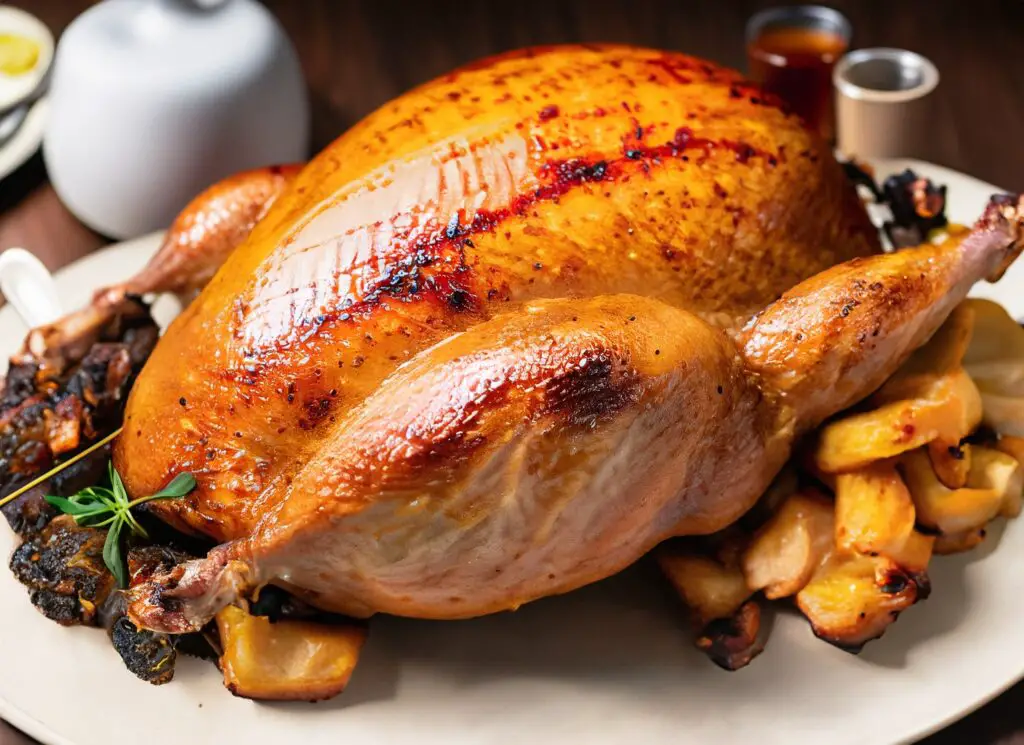Are you tired of overcooked or undercooked turkey?
Cooking a turkey can be a daunting task, especially when it comes to ensuring it’s cooked to the perfect temperature.
But don’t worry! I’m here to help you figure out where to put thermometer in turkey and share some essential cooking tips. With my years of experience in cooking and food safety, I can guide you through the process of achieving a delicious and safe turkey dish.
Where to Put Thermometer in Turkey?

The best place to put a thermometer in a turkey is in the thickest part of the breast or thigh, without touching bone. Here are the steps on how to insert a thermometer into a turkey:
- Remove the giblets and neck from the turkey cavity.
- Place the turkey breast side up on a roasting pan.
- Insert the thermometer probe into the thickest part of the breast meat, without touching bone.
- Insert the probe horizontally, from near the neck cavity.
- The probe’s tip should be about 1/2 to 1 inch (1.3 to 2.5 cm) from the internal cavity of the bird to avoid touching the bone.
- If you are using a leave-in thermometer, secure the probe in place with a piece of tape or a zip tie.
- Roast the turkey according to the recipe instructions.
- When the turkey is cooked through, the internal temperature should reach 165 degrees Fahrenheit (74 degrees Celsius) in the thickest part of the breast or thigh.
- Remove the turkey from the oven and let it rest for 15 minutes before carving.
Key Takeaway: The best place to put a thermometer in a turkey is in the thickest part of the breast or thigh, without touching bone.
Here are some additional tips for using a thermometer to cook a turkey:
- Use a digital thermometer for the most accurate readings.
- Check the temperature of the turkey every 30 minutes or so while it is cooking.
- Do not open the oven door more than necessary, as this will release heat and slow down the cooking process.
- Let the turkey rest for 15 minutes before carving. This will allow the juices to redistribute throughout the meat, resulting in a more tender and juicy turkey.
Proper Thermometer Placement in Turkey
Proper thermometer placement is crucial for accurate temperature readings. There are two main areas to consider when inserting a thermometer into a turkey: the thigh and the breast.
Turkey Thigh Thermometer Placement
- Locate the thickest part of the thigh, avoiding contact with the bone.
- Insert the thermometer probe into the meat at a slight angle, ensuring it doesn’t touch the bone.
- Monitor the temperature throughout cooking, aiming for an internal temperature of 165°F (74°C).
Tip: Inserting the thermometer probe at a slight angle helps avoid contact with bones and ensures accurate temperature readings.
Correct Thermometer Location in Turkey Breast
- Locate the thickest part of the breast, avoiding contact with any bones.
- Insert the thermometer probe horizontally into the meat, ensuring it doesn’t touch any bones.
- Monitor the temperature throughout cooking, aiming for an internal temperature of 165°F (74°C).
Monitoring Turkey Temperature
Monitoring your turkey’s temperature throughout the cooking process is essential to ensure it reaches a safe internal temperature. A meat thermometer plays a crucial role in achieving this goal. Here are some tips on how often to check your turkey’s temperature and how to avoid undercooking or overcooking:
- Check your turkey’s temperature every 30 minutes during cooking.
- Use an oven-safe thermometer or a leave-in meat thermometer for continuous monitoring.
- Ensure all parts of your turkey reach a minimum internal temperature of 165°F (74°C) to avoid foodborne illnesses.
Key Takeaway: Monitoring your turkey’s temperature throughout cooking is essential to ensure it reaches a safe internal temperature of 165°F (74°C).
Tips for Accurate Thermometer Placement in Turkey
To ensure accurate thermometer placement in your turkey, follow these practical tips:
- Use your fingers to feel for the thickest parts of the thigh and breast.
- Insert the thermometer probe at a slight angle to avoid contact with bones.
- Consider using an oven-safe thermometer or a leave-in meat thermometer for continuous temperature monitoring.
Ensuring Safe Cooking Temperature for Turkey
Different parts of your turkey, such as the thigh, breast, and stuffing, require specific internal temperatures to ensure safe consumption. The minimum safe temperature to avoid foodborne illnesses is 165°F (74°C). Some common questions include:
- Is turkey done at 165 or 180? Turkey is considered safe to eat when it reaches an internal temperature of 165°F (74°C) in all parts.
- Where do you put the pop-up thermometer in a turkey? Insert the pop-up thermometer into the thickest part of the thigh, avoiding contact with bones.
Using a Meat Thermometer for Turkey: Step-by-Step Guide
Here’s a step-by-step guide on how to use a meat thermometer effectively when cooking a turkey:
- Calibrate your thermometer according to the manufacturer’s instructions.
- Choose the right type of meat thermometer for your needs, such as an oven-safe thermometer or a leave-in thermometer.
- Follow the proper insertion techniques for each part of the turkey, as described earlier in this article.
- Monitor your turkey’s temperature throughout cooking and ensure all parts reach a minimum internal temperature of 165°F (74°C).
Key Takeaway: Using a meat thermometer effectively when cooking a turkey involves calibrating the thermometer, choosing the right type, and following proper insertion techniques.
FAQs About Thermometer Turkey
Is it better to cook a turkey at 325 or 400?
Cooking a turkey at a lower temperature, like 325°F (163°C), results in more even cooking and juicier meat. However, it takes longer than cooking at a higher temperature like 400°F (204°C).
Where to poke a turkey for temperature and what temperature should it be?
Poke the turkey in the thickest part of the thigh or breast, avoiding contact with bones. The internal temperature should be 165°F (74°C).
How to check turkey temperature without a thermometer?
You can check the turkey’s doneness by piercing the thickest part of the thigh with a fork. If the juices run clear, the turkey is likely done. However, using a thermometer is the most accurate method.
How long to cook a turkey?
The cooking time depends on the size and weight of your turkey, as well as your oven’s temperature. Generally, it takes about 13-15 minutes per pound at 325°F (163°C).
Summary
Proper thermometer placement is essential for cooking a safe and delicious turkey. By following the tips and techniques outlined in this article, you’ll be well on your way to mastering the art of cooking a perfect turkey every time. So, grab your meat thermometer and get ready to impress your family and friends with a juicy, tender, and flavorful turkey dish!





